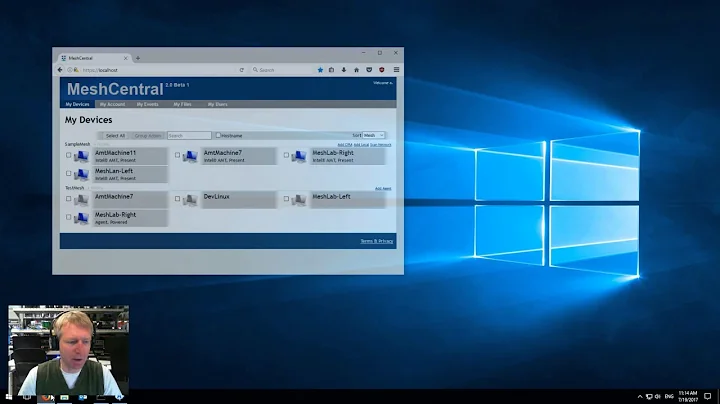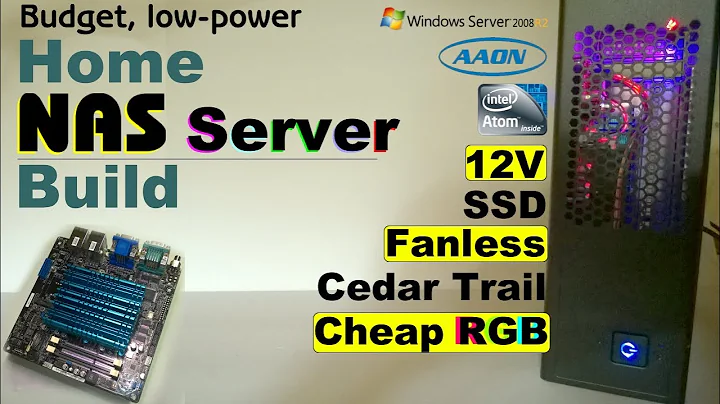Boost Network Encryption with Intel Quick Assist
Table of Contents
- Introduction
- What is Quick Assist?
- Quick Assist Accelerator
- Cryptographic Ciphers
- Asymmetric Cryptography
- Compression
- Physical Instantiation of Quick Assist
- PCI Connection
- Chipset
- PCI Express Card
- So Form Factor or C2000 Class
- Popular Algorithms Supported by Quick Assist
- AES
- SHA
- RSA
- Elliptic Curve Diffie-Hellman
- Curve25519
- ECDH and ECDSA
- Wireless Ciphers
- Performance and Features of Quick Assist
- Integration with Applications and Frameworks
- Operating System Support
- Hypervisor Support
- Applications Support
- File System Support
- Database Support
- Benchmarking Results
- Open SSL Performance
- Storage Compression Performance
- Hadoop Compression Performance
- Conclusion
- Resources
Introduction
Quick Assist Technology, also known as Quick Assist, is an accelerator that provides cryptographic, authentication, and compression capabilities. It is designed to enhance the performance and efficiency of various applications, particularly in the networking and storage spaces. This article aims to give you a comprehensive understanding of Quick Assist, its physical instantiations, supported algorithms, integration with different frameworks, and its benchmarking results.
What is Quick Assist?
Quick Assist is an accelerator that provides hardware-based acceleration for cryptographic ciphers, asymmetric cryptography, and compression. It offers high-performance capabilities that enhance the security and efficiency of various applications, including networking and storage. Quick Assist can be implemented through different physical instantiations, such as a PCI connection, chipset, PCI Express card, or in the form of an So (System-on-a-Chip) class.
Quick Assist Accelerator
Cryptographic Ciphers
Quick Assist includes cryptographic ciphers that can accelerate encryption and decryption operations. It supports popular ciphers like AES (Advanced Encryption Standard) and various SHA (Secure Hash Algorithm) variants. These ciphers are commonly used in network protocols like IPsec and SSL/TLS to ensure secure communications.
Asymmetric Cryptography
Asymmetric cryptography, also known as public key cryptography, is a crucial component of secure communication protocols. Quick Assist accelerates asymmetric cryptography operations, including RSA (Rivest-Shamir-Adleman) and elliptic curve cryptography (ECC). It enables faster key exchange, digital signatures, and data encryption.
Compression
Quick Assist also provides compression capabilities that can significantly reduce data size and improve storage and network efficiency. It supports popular compression algorithms like DEFLATE, which is the standard algorithm used in applications like zlib.
Physical Instantiation of Quick Assist
Quick Assist is available in different physical instantiations, each offering unique performance and compatibility features. Here are the main types:
PCI Connection
Quick Assist can be connected to a system using a PCI connection. It can be integrated either as a separate card or a chipset built into a standard server platform. Different performance envelopes are available based on the specific chipset or card used.
Chipset
Some server platforms come with built-in Quick Assist capabilities integrated into the chipset. These chipsets provide a range of performance options to suit different application requirements.
PCI Express Card
Quick Assist can be implemented as a separate PCI Express card. These cards are produced by various vendors and can be purchased to add quick assist capabilities to a system. The performance and throughput of these cards may vary depending on the specific model.
So Form Factor or C2000 Class
Quick Assist can also be integrated into system-on-a-chip (So) architectures or C2000 class processors. These processors have Quick Assist capabilities built directly into the chip itself, offering a more compact and integrated solution.
Popular Algorithms Supported by Quick Assist
Quick Assist supports a wide range of popular algorithms used in cryptography and compression. Here are some of the commonly supported algorithms:
AES
AES (Advanced Encryption Standard) is widely used for symmetric encryption. It is a block cipher that provides high security and speed for data encryption and decryption operations.
SHA
SHA (Secure Hash Algorithm) is a family of cryptographic hash functions used for data integrity verification and digital signatures. Quick Assist supports various SHA variants, including SHA-1, SHA-256, and SHA-512.
RSA
RSA is an asymmetric encryption algorithm widely used for secure key exchange, digital signatures, and encryption. Quick Assist provides acceleration for RSA operations, improving performance in tasks that involve RSA encryption or decryption.
Elliptic Curve Diffie-Hellman
Elliptic Curve Diffie-Hellman (ECDH) is an asymmetric key exchange algorithm based on elliptic curve cryptography. Quick Assist accelerates ECDH operations, enabling faster and more efficient key exchange.
Curve25519
Curve25519 is an elliptic curve, specifically designed to provide high security and performance. It is widely used in cryptographic protocols like Transport Layer Security (TLS).
ECDSA
ECDSA (Elliptic Curve Digital Signature Algorithm) is an asymmetric cryptographic algorithm used to create and verify digital signatures. Quick Assist supports ECDSA, enhancing the efficiency of digital signature operations.
Wireless Ciphers
Quick Assist also supports various wireless ciphers like Cumulative Snooping, 3G, and others commonly used in wireless communication protocols.
Pros:
- Quick Assist accelerates cryptographic operations, providing improved security and efficiency in applications.
- It offers support for a wide range of popular algorithms, ensuring compatibility with various cryptographic standards.
- Quick Assist can be implemented in different physical instantiations, providing flexibility and compatibility with different systems and architectures.
Cons:
- The performance and capabilities of Quick Assist may vary depending on the specific chipset, card, or So form factor used.
- Integration with applications and frameworks may require additional development and modifications to leverage the full benefits of Quick Assist.
Performance and Features of Quick Assist
Quick Assist delivers high-performance capabilities for cryptographic operations and compression. Here are some key performance features of Quick Assist:
- Quick Assist can achieve high data transfer rates, supporting up to 50 gigabits per Second for bulk crypto operations and up to 24 gigabits per second for compression.
- It provides significant reductions in CPU utilization compared to software-based approaches, enabling more efficient utilization of system resources.
- Quick Assist supports a wide range of standard crypto algorithms, including AES, RSA, SHA, and elliptic curve cryptography.
- It offers features like authentication modes, hash functions, and wireless ciphers, ensuring compatibility with various encryption and communication standards.
- Quick Assist is designed to integrate seamlessly with different operating systems, hypervisors, and applications, minimizing the effort required for integration and compatibility.
Integration with Applications and Frameworks
Quick Assist can be effectively integrated into various applications and frameworks, providing hardware-based acceleration for cryptographic and compression operations. Here are some key integration points:
Operating System Support
Quick Assist has support in major operating systems like Linux, Windows, and FreeBSD. It provides drivers and libraries that allow applications to leverage Quick Assist capabilities seamlessly.
Hypervisor Support
Quick Assist is compatible with popular hypervisors like KVM, VMware, and Xen. It enables acceleration of cryptographic operations for virtualized environments, improving performance and efficiency.
Applications Support
Quick Assist can be integrated into applications and frameworks like OpenSSL, Engine X, Squid, and Hadoop. These integrations enable applications to offload cryptographic and compression operations to Quick Assist, boosting overall performance.
File System Support
Quick Assist can work with file systems like Btrfs and provide hardware-accelerated compression capabilities. It ensures efficient storage utilization and improves overall system performance.
Database Support
Quick Assist can be integrated with databases like RocksDB and MongoDB, enhancing performance by accelerating compression and cryptographic operations. It enables faster data storage and retrieval in database systems.
Benchmarking Results
Benchmarking results showcase the performance benefits of Quick Assist in various scenarios. Here are some key findings from benchmark tests:
- Quick Assist, when integrated with OpenSSL, improves SSL connection throughput significantly. It can achieve over 40,000 SSL connections per second, compared to software-only solutions that reach around 6,700 connections per second.
- In storage compression benchmarks, Quick Assist consistently delivers high compression ratios while utilizing a fraction of CPU resources compared to software-based compression algorithms like Zlib. It can reduce data size by up to 70% with only a small increase in CPU utilization.
- Quick Assist integration with big data frameworks like Hadoop provides faster compression and decompression operations, resulting in improved overall job completion time.
These benchmarks demonstrate the performance and efficiency gains that Quick Assist brings to various applications, making it a valuable tool in cryptography, compression, and storage optimization.
Conclusion
Quick Assist Technology offers hardware-based acceleration for cryptographic ciphers, asymmetric cryptography, and compression. With its wide range of supported algorithms and seamless integration with applications and frameworks, Quick Assist provides significant performance improvements and efficiency gains. Whether it's enhancing SSL/TLS connections, improving storage compression ratios, or accelerating big data processing, Quick Assist proves to be a valuable addition to any system. Its flexibility in physical instantiations further adds to its appeal, making it suitable for a range of applications and architectures.
Resources


 15.6K
15.6K
 66.97%
66.97%
 4
4


 < 5K
< 5K
 17.89%
17.89%
 4
4


 1.4M
1.4M
 16.95%
16.95%
 5
5


 27.1K
27.1K
 9.92%
9.92%
 22
22


 874.9K
874.9K
 22.98%
22.98%
 12
12


 5.5K
5.5K
 62.75%
62.75%
 7
7


 < 5K
< 5K
 14
14


 11.1K
11.1K
 38.23%
38.23%
 2
2


 < 5K
< 5K
 31.34%
31.34%
 4
4


 61K
61K
 31%
31%
 3
3


 247.3K
247.3K
 26.72%
26.72%
 5
5


 14.5K
14.5K
 62.5%
62.5%
 2
2
 WHY YOU SHOULD CHOOSE TOOLIFY
WHY YOU SHOULD CHOOSE TOOLIFY



































